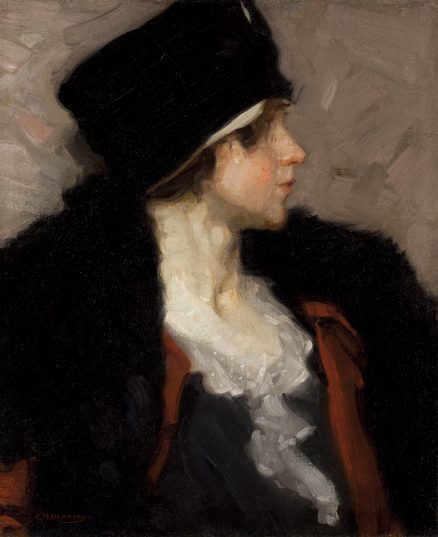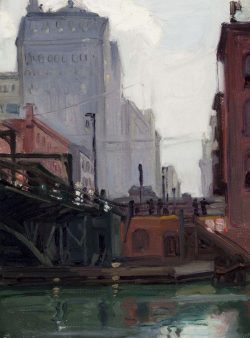- Categories
- Figural works
- Women
- Zoom in on Artwork
- Print Page
- Email Page to Friend
E. Martin Hennings’s Black Furs is an exercise in composing in a limited range of colors using dramatic contrasts of light and dark. Superficially, it is an elegant bust portrait of a young woman, her body set at an angle to the viewer and her head turned to show her face in profile. A fashionable black hat is pulled close around her face, while above the lace collar of a black dress her slender white throat is exposed, its whiteness accentuated by contrast with the black fur covering her shoulders over a red coat. Her hat and shoulders cropped on either side, the subject is pressed close to the picture plane. Yet she remains psychologically inaccessible, less an individual than a vehicle for demonstrating the artist’s skills in composition and in the manipulation of paint to suggest tactile surfaces, from luminous flesh to soft fur.
Hennings showed Black Furs in the Art Institute’s 1916 “Chicago and Vicinity” exhibition, which opened only six months after his return from Europe following the outbreak of World War I. The dark tones and bravura brushwork of this painting, also demonstrated in Hennings’s nearly contemporary Study for The Bridge, are hallmarks of the style he absorbed during two years of study at the Royal Academy in Munich. Black Furs in particular seems calculated to advertise not only the artist’s cosmopolitan technique but also his command of the conventions of the fashionable portrait as a statement of both sitter’s and artist’s aesthetic sophistication. In the 1916 Art Institute exhibition, the painting was one of five for which Hennings received a prize from the Englewood Woman’s Club. “‘Black Furs’ contain[s] the elements of a promising career,” enthused the reviewer for the Chicago Post.i In the following years, Hennings exhibited more portraits and figure paintings at the Art Institute. Beginning in 1917, however, he turned his attention to the Southwest to execute the images of American Indians that effectively secured his reputation.
Wendy Greenhouse, PhD
i “Art and Artists,” Chicago Post, Feb. 12, 1916.

